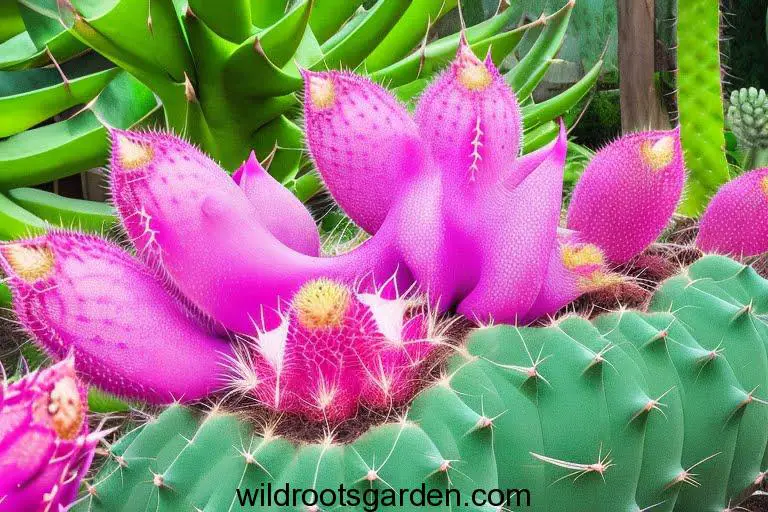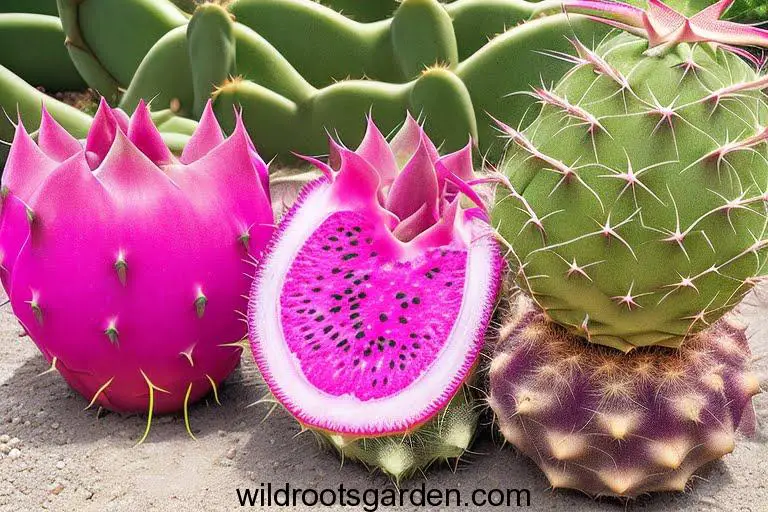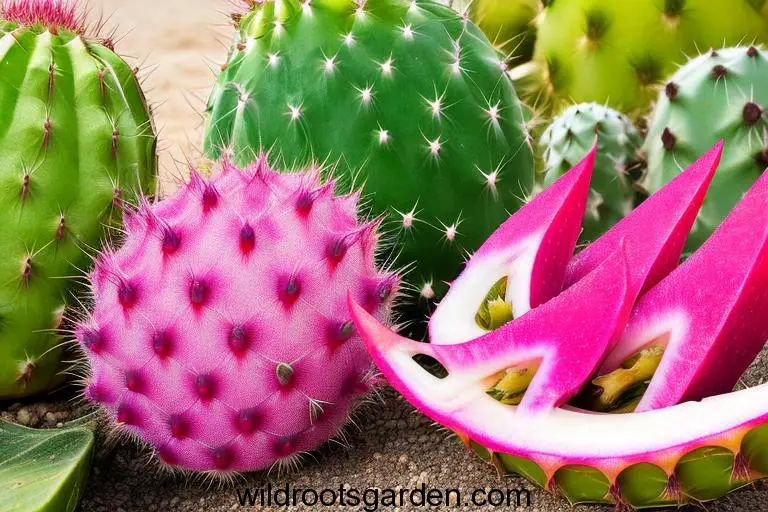Cactus fruit and dragon fruit are two exotic fruits that have gained popularity in recent years due to their unique appearance and potential health benefits. While both fruits belong to the cactus family, they differ in terms of taste, nutritional value, and culinary uses. In this article, we will explore the distinctions between cactus fruit and dragon fruit, highlighting their characteristics, benefits, and versatility in various aspects.
Table of Contents
Definition of Cactus Fruit
The term “cactus fruit,” often referred to as “prickly pear” or “tunas,” describes the fruit of various Opuntia genus cacti species. Typically, the outer peel of these fruits is thick and prickly, shielding the luscious pulp and countless tiny seeds inside. Depending on the particular kind, cactus fruit comes in a range of hues, including red, yellow, green, and purple.

Definition of Dragon Fruit
Pitaya, also referred to as dragon fruit, is a tropical fruit that comes from Central and South America. It originates from several cacti species, especially from the Hylocereus genus. Dragon fruit has a colorful, eye-catching look with a distinctive shape that resembles a dragon’s scales. The fruit’s flesh, which can be white or deep magenta and is flecked with tiny black seeds, has skin that is frequently bright pink or yellow.
Cactus Fruit vs Dragon Fruit:
Appearance and Color
The shape of the cactus fruit is round or oval, like a pear or an elongated oval. Glochids, the fruit’s tiny spines that cover its skin, can be difficult to remove. Cactus fruit can range in color from bright red to yellow or green, depending on the variety. Usually juicy, the pulp has numerous tiny seeds embedded within it.
Dragon fruit, on the other hand, has an eye-catching look thanks to its vivid, frequently neon-like colors. It has a unique texture due to the scales or spikes on its outer epidermis. The smooth, varying shades of white to deep magenta dragon fruit flesh stand in stark contrast to the black seeds that are scattered throughout.
Taste and Flavor
Cactus fruit offers a distinctive fusion of ingredients in terms of taste. The flavor profile is frequently described as a blend of sweet and tart, with certain kinds displaying delicate strawberry, kiwi, or melon undertones. The fruit’s level of maturity will determine how solid or somewhat mushy the pulp is.

The flavor of dragon fruit, on the other hand, is softer and more delicate. Its flavor is frequently characterized as gently sweet with undertones that taste like a cross between a kiwi and a pear. Because of the seeds’ presence, the flesh has a pleasing mouthfeel and is smooth with a hint of crunch.
Nutritional Value
Both cactus fruit and dragon fruit have many health advantages. The cactus fruit is low in calories and has a high amount of dietary fiber, both of which support a healthy digestive system and aid in digestion. Together with minerals like magnesium, calcium, and potassium, it also includes vital vitamins including vitamin C, vitamin A, and vitamin B6.
Dragon fruit is equally nutrient-dense and is high in antioxidants, which work to fend off free radicals and prevent cell deterioration. Moreover, it has a lot of vitamin C, which gives the immune system a powerful boost. In addition, the presence of iron, phosphorus, and many B vitamins in dragon fruit supports general health.
Health Benefits of Cactus Fruit
As a result of its nutrient-rich makeup, cactus fruit provides a wide range of health advantages. The high fiber content helps to maintain balanced blood sugar levels, encourages a healthy digestive system, and avoids constipation. The vitamin C in the fruit strengthens the immune system and encourages the creation of collagen, which helps to maintain healthy skin and support tissue healing.
In addition, cactus fruit includes antioxidants that defend against cellular damage brought on by free radicals, reduce inflammation, and minimize the risk of chronic illnesses. The potassium in the fruit helps to maintain healthy heart function and control blood pressure.
Health Benefits of Dragon Fruit
The health advantages of dragon fruit are comparable to those of cactus fruit. Its antioxidants aid in maintaining a strong immune system and lessen oxidative stress. The high vitamin C content of dragon fruit promotes healthy skin and speeds up wound healing by assisting in the creation of collagen.

The fruit’s fiber content also promotes healthy gut microbiota and aids with digestion. Also, the prebiotics in dragon fruit feeds the good bacteria in the gut, promoting a healthy and active digestive tract. The iron in dragon fruit can help avoid anemia and encourage the best possible oxygen delivery throughout the body.
Culinary Uses of Cactus Fruit
A flexible component, cactus fruit can be employed in a variety of culinary preparations. It is frequently juiced, producing a cool beverage with a vivid hue. The juice can also be used to make sauces, and syrups, or to lend a healthy edge to smoothies. Jams, jellies, and sweets can all benefit from the addition of cactus fruit to give them a distinctive flavor and aesthetic appeal.
Culinary Uses of Dragon Fruit
The visually pleasing look of dragon fruit makes it a preferred component in exotic fruit salads and desserts. For an explosion of color and taste, the flesh can be scooped out and consumed on its own or added to fruit bowls and smoothies. The look of cakes and pastries can be improved by adding dragon fruit to sorbets, ice creams, and even as a topping.

Cultivation and Availability
Warm climates are ideal for growing cactus fruit and dragon fruit, which are mainly grown in Southeast Asia, Central America, and Mexico. Nonetheless, they are currently grown all over the world as a result of rising worldwide demand. In regions with the right climate, cactus fruit can be cultivated in backyard gardens, specialist food stores, and even farmers’ markets. Dragon fruit is getting easier to find and is frequently seen in supermarkets, especially in regions with a large variety of fruits.
Price and Accessibility
Availability and location can affect the cost of cactus fruit and dragon fruit. In general, cactus fruit is less expensive than dragon fruit, which is frequently regarded as a luxury fruit. Yet, as dragon fruit farming spreads, its cost has decreased, making it more affordable for a larger range of consumers.
Side Effects and Precautions
Although cactus fruit and dragon fruit are typically healthy to eat, caution is advised, especially for people with certain medical issues. Cactus fruit must be handled carefully, and the spines must be removed before eating to prevent skin discomfort or harm. Also, because cactus fruit naturally contains sugar, people with diabetes should watch how much of it they consume.
On the other hand, those who have fruit allergies, especially those who are sensitive to kiwi, pineapple, or other tropical fruits, may experience adverse reactions to dragon fruit. As with any new cuisine, it is best to start with a tiny serving and watch for any negative reactions.
Comparison between Cactus Fruit and Dragon Fruit
Both cactus fruit and dragon fruit belong to the cactus family, but they have some differences. Cactus fruit has a tangy and refreshing flavor, while dragon fruit is softer and sweeter in taste. Dragon fruit has a unique shape and vibrant colors, while cactus fruit has a tough, spiky skin.
Both fruits are highly nutritious and contain important vitamins and minerals. However, cactus fruit is higher in fiber, while dragon fruit has more antioxidants. When it comes to culinary uses, cactus fruit is commonly juiced, used in jams or added to sweets, while dragon fruit is often found in desserts, salads, and as a snack.
Conclusion
To sum up, cactus fruit and dragon fruit are two exotic fruits that bring a burst of flavor and color to meals. Despite sharing a common cactus origin, they each possess unique characteristics, flavors, and nutritional benefits. Whether you prefer the visually stunning appeal of dragon fruit or the tangy and refreshing taste of cactus fruit, both fruits are a tasty addition to a variety of recipes and may offer numerous health benefits.
FAQs (Frequently Asked Questions)
Are cactus fruit and dragon fruit the same thing?
No, they are unique fruits that are related to cacti but have different qualities and tastes.
Can cactus fruit and dragon fruit be eaten raw?
You can eat both fruits uncooked. But before eating cactus fruit, it’s vital to remove the spines.
Are cactus fruit and dragon fruit good for weight loss?
Because of their low calorie and high fiber contents, both fruits can be a component of a wholesome weight loss diet. Nonetheless, it’s crucial to take your total calorie intake and dietary balance into account.
Can cactus fruit and dragon fruit be grown at home?
Both fruits may be grown in home gardens or containers with the right care and attention if you reside in an area with a suitable environment.
Where can I buy cactus fruit and dragon fruit?
Farmers’ markets, specialty grocers, and supermarkets that provide a wide variety of fruits carry cactus fruit and dragon fruit.
There can be some confusion around “cactus fruit” and “dragon fruit,” as they might refer to the same thing or distinct concepts! Here are some website resources to help you:
General Comparison:
- The Foodie Physician: https://www.momswhothink.com/pitaya-vs-dragon-fruit-whats-the-difference/ This website clarifies the difference between dragon fruit and “pitaya,” which is another term used for certain types of cactus fruit. It explains their botanical origins and shared characteristics like appearance, taste, and uses.
- Mindfully Healthy Living: https://smallkitchenguide.com/dragon-fruit-vs-prickly-pear/ This site compares dragon fruit with prickly pear, another popular edible cactus fruit. It highlights their distinct colors, textures, seeds, and nutritional profiles.
Specifics about Dragon Fruit:
- Wikipedia: https://en.wikipedia.org/wiki/Pitaya This comprehensive article details the various species of dragon fruit, their cultivation, history, nutritional value, and culinary uses. You’ll find pictures and information about the most common red-fleshed and white-fleshed varieties.
- Healthline: https://www.healthline.com/nutrition/dragon-fruit-benefits This health-focused website discusses the potential health benefits of dragon fruit, including its high antioxidant content, fiber content, and possible role in blood sugar control.
Resources on Prickly Pear:
- Fine Gardening: https://www.youtube.com/watch?v=xGkbgHAqoEg This website offers practical tips on growing and harvesting prickly pears, as well as recipes for incorporating them into your diet. You’ll find information about their unique flavor and culinary applications.
- The Spruce Eats: https://www.rxlist.com/supplements/prickly_pear_cactus.htm This website delves into the various uses of prickly pears beyond the fruit, including using the pads for food and the spines for making crafts. It provides a broader perspective on this versatile cactus.
Additionally:
- You can conduct Google image searches for “cactus fruit” and “dragon fruit” to visually compare their appearances.
- If you have a specific question about cactus fruit or dragon fruit, feel free to ask!
I hope these resources help you understand the differences and similarities between these interesting fruits!

